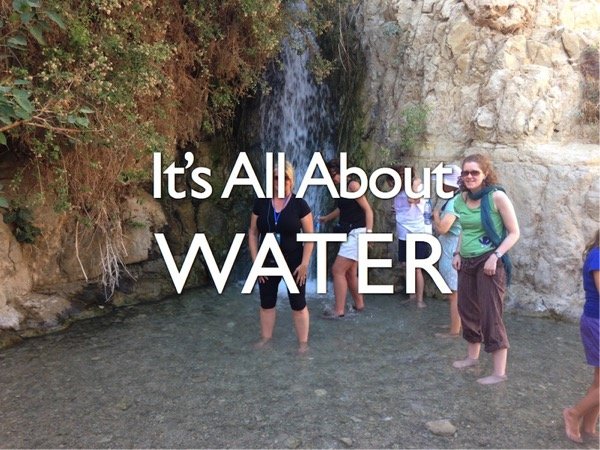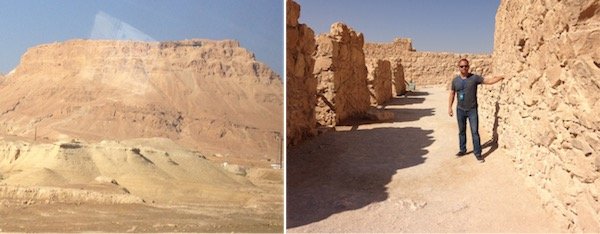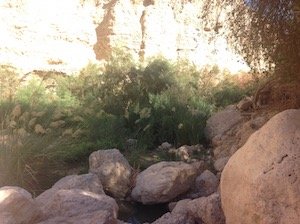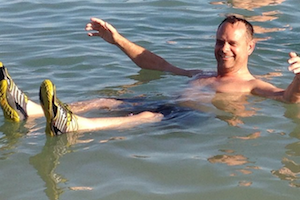Israel – Day Six
 Every settlement, village, or city in the ancient world had to have a water source. The nomads even chose their temporary encampments by proximity to water source, and they wandered the desert following the vegetation, which follows the water. The Bedouins are today’s nomads of the Middle East and that’s exactly what they do. They follow the water.It’s all about water for everything living. It’s not as stark in the modern developed world or in climates such as ours, because water is readily available. But it’s readily available because it has always been such a necessity that our predecessors ingeniously developed ways to drill for it, pipe it and purify it. Even in our world, life is all about water.And we saw that today.We started our morning at Masada. Masada was a desert fortress built by Herod the Great shortly before Jesus was born. It is a table top mountain on the southwest side of the Dead Sea and towers 1,500 feet high (still below sea level). The mountain walls are so high and so steep that as a fortress, it is nearly impregnable. The top was fully constructed of stone and was filled with storage facilities for grain, a dovecoat for raising doves for meat, a garden for growing fresh vegetables, and giant cisterns for storing enough water to last several years. Harod also built an opulent palace, in case he ever needed to be there, complete with ornate floor mosaics and wall frescos, an elaborate sauna bath, giant pillars at the entrance, and a semi-circle viewing area. It was an engineering marvel.
Every settlement, village, or city in the ancient world had to have a water source. The nomads even chose their temporary encampments by proximity to water source, and they wandered the desert following the vegetation, which follows the water. The Bedouins are today’s nomads of the Middle East and that’s exactly what they do. They follow the water.It’s all about water for everything living. It’s not as stark in the modern developed world or in climates such as ours, because water is readily available. But it’s readily available because it has always been such a necessity that our predecessors ingeniously developed ways to drill for it, pipe it and purify it. Even in our world, life is all about water.And we saw that today.We started our morning at Masada. Masada was a desert fortress built by Herod the Great shortly before Jesus was born. It is a table top mountain on the southwest side of the Dead Sea and towers 1,500 feet high (still below sea level). The mountain walls are so high and so steep that as a fortress, it is nearly impregnable. The top was fully constructed of stone and was filled with storage facilities for grain, a dovecoat for raising doves for meat, a garden for growing fresh vegetables, and giant cisterns for storing enough water to last several years. Harod also built an opulent palace, in case he ever needed to be there, complete with ornate floor mosaics and wall frescos, an elaborate sauna bath, giant pillars at the entrance, and a semi-circle viewing area. It was an engineering marvel. I don’t have time here to tell the story of the nearly 1,000 Jews who attacked and held the fortress for over three years, before the Romans were finally able to defeat them by building a huge ramp leading up to the top of the mountain. But the part I want to point out is that while this place is in the middle of a desert, a large group of people were able to keep themselves alive though cut off from the outside world, because they had enough water to last for years, even without replenishing their cisterns. We enjoyed looking at the beautiful workmanship among the ruins and the ingenuity of everything about the outpost, but we spent a big part of our time learning about the water collection, storage, and recycling system on the mountain. The design was incredible. It had to be. This was and is a desert and people need water to survive.
I don’t have time here to tell the story of the nearly 1,000 Jews who attacked and held the fortress for over three years, before the Romans were finally able to defeat them by building a huge ramp leading up to the top of the mountain. But the part I want to point out is that while this place is in the middle of a desert, a large group of people were able to keep themselves alive though cut off from the outside world, because they had enough water to last for years, even without replenishing their cisterns. We enjoyed looking at the beautiful workmanship among the ruins and the ingenuity of everything about the outpost, but we spent a big part of our time learning about the water collection, storage, and recycling system on the mountain. The design was incredible. It had to be. This was and is a desert and people need water to survive. We then visited Ein Gedi, the wilderness area where David hid from Saul. It is located just a little way from Masada and is in the same desert. Every where you look surrounding Ein Gedi, it is barron. It’s all just rocks, sand and mountains, a very rugged land. And then in the middle of this desert is a meandering strip of lush greenery and thriving wildlife. Because here in the desert is a spring that flows out of the side of a mountain, like a waterfall (see the title picture), creating a watering stream where life is supported in full bloom. And that water and all that vegetation and even the animal life supported David and his army of defenders during their time in the desert. We waded in the pool at the bottom of the waterfall and hiked the trail alongside the stream, observing conies and other desert animals. The canyon walls were peppered with caves and I was reminded of the story when David hid just a few feet away from Saul in one of those caves.
We then visited Ein Gedi, the wilderness area where David hid from Saul. It is located just a little way from Masada and is in the same desert. Every where you look surrounding Ein Gedi, it is barron. It’s all just rocks, sand and mountains, a very rugged land. And then in the middle of this desert is a meandering strip of lush greenery and thriving wildlife. Because here in the desert is a spring that flows out of the side of a mountain, like a waterfall (see the title picture), creating a watering stream where life is supported in full bloom. And that water and all that vegetation and even the animal life supported David and his army of defenders during their time in the desert. We waded in the pool at the bottom of the waterfall and hiked the trail alongside the stream, observing conies and other desert animals. The canyon walls were peppered with caves and I was reminded of the story when David hid just a few feet away from Saul in one of those caves. The highlight of the day for everyone had to be swimming in the Dead Sea. I love to swim and have heard others talk about the Dead Sea and have wanted to swim in it since I was a boy when I first had a teacher describing what it was like. It’s beyond description. The Dead Sea has ten times the concentration of salt as the ocean. That concentration of salt makes it very buoyant. You cannot sink in the Dead Sea. Floating on it is almost like laying on top of the water. I went deep, well past being over my head, and was able to stand upright without my feet touching the bottom and without kicking my shoulders remained above the water. It’s hard to describe. You have to experience it yourself.But also, because of that concentration of salt and other minerals, nothing, absolutely nothing is able to live in it. The salt and concentration of other minerals kills all bacteria and any other life that may find it’s way into the water. There are no fish, sea mammals, amphibians or microbes. It is completely sterile.Why? because The Dead Sea has an inlet but no outlet. Salt and minerals are deposited and as the water is evaporated in the hot desert sun, the salt and minerals are left behind. So the sea is dead.It is so unlike Ein Gedi, where the water flows, is fresh and alive. It is water that brings and supports life. The Dead Sea takes it all in but gives nothing out. And it is dead.And the people I know fall into one of those categories. You are either receiving and giving, alive, fresh and breathing life into others. Or you are taking and holding, stagnant, sterile, death to self and dead to others.Which are you? Do you have an inlet and outlet? If you have no inlet, you will dry out. If you have not outlet, no means to give and serve, you stagnate, or become so concentrated with what you’ve been given that you support no one else, and die from the inside out.It’s all about the water. And when it comes to water, it’s all about giving it out as you are taking it in.Are you?
The highlight of the day for everyone had to be swimming in the Dead Sea. I love to swim and have heard others talk about the Dead Sea and have wanted to swim in it since I was a boy when I first had a teacher describing what it was like. It’s beyond description. The Dead Sea has ten times the concentration of salt as the ocean. That concentration of salt makes it very buoyant. You cannot sink in the Dead Sea. Floating on it is almost like laying on top of the water. I went deep, well past being over my head, and was able to stand upright without my feet touching the bottom and without kicking my shoulders remained above the water. It’s hard to describe. You have to experience it yourself.But also, because of that concentration of salt and other minerals, nothing, absolutely nothing is able to live in it. The salt and concentration of other minerals kills all bacteria and any other life that may find it’s way into the water. There are no fish, sea mammals, amphibians or microbes. It is completely sterile.Why? because The Dead Sea has an inlet but no outlet. Salt and minerals are deposited and as the water is evaporated in the hot desert sun, the salt and minerals are left behind. So the sea is dead.It is so unlike Ein Gedi, where the water flows, is fresh and alive. It is water that brings and supports life. The Dead Sea takes it all in but gives nothing out. And it is dead.And the people I know fall into one of those categories. You are either receiving and giving, alive, fresh and breathing life into others. Or you are taking and holding, stagnant, sterile, death to self and dead to others.Which are you? Do you have an inlet and outlet? If you have no inlet, you will dry out. If you have not outlet, no means to give and serve, you stagnate, or become so concentrated with what you’ve been given that you support no one else, and die from the inside out.It’s all about the water. And when it comes to water, it’s all about giving it out as you are taking it in.Are you?